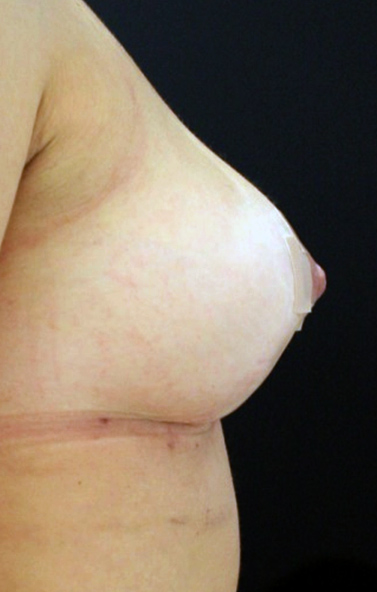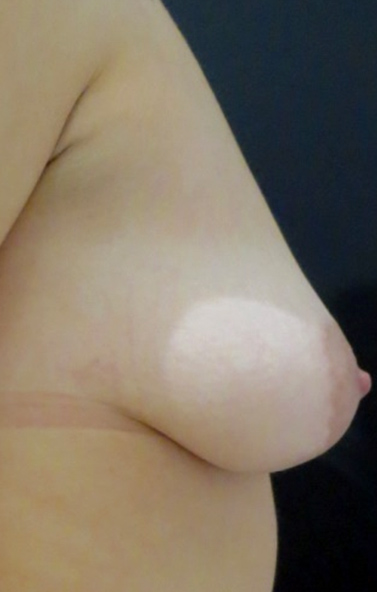Breast Lift
A breast lift helps the breasts to return to their normal position. Breast sagging is a common complaint of women and the main causes are:
- Sagging and poor skin quality due to age
- Smoking
- Aging of the skin and deterioration of the skin due to age and bad skin quality
- Weight and size of the breasts
- Large weight fluctuations
Breast lift – Which surgical technique is used?
The breast lift technique involves mobilizing the breast and nipple upwards and then removing the excess skin. Many times in conjunction with a breast lift, breast reduction or breast augmentation (with fat or silicone prostheses) can be performed. All of this is discussed at the pre-operative appointment with the Plastic Surgeon. The most important question is whether the breast volume satisfies the patient. If the volume is satisfactory, a simple breast lift is what the patient needs. On the other hand, if the volume is below the desired, then a breast augmentation with silicone or fat prostheses should be performed at the same time as the breast lift. It is necessary to have a medical check-up of the breast with ultrasound or mammography before the surgery.
Do I need hospitalization after the breast lift?
The surgery is performed under general anesthesia. A hospital stay may not be necessary and in most cases does not exceed one day. Recovery is short, as the patient can return to her daily routine after about 4 to 10 days, depending on the nature of her work.
Breast lift – Postoperative instructions
The incisions in the breast lift are discreet and are mainly confined around and under the nipple. Breastfeeding is most cases is not affected. The final result is fully visible after the first year of the surgery.
After surgery, the breasts are in a very high position but gradually fall naturally.
Breast lift – FAQ
What is the stage of the breast drop? How do we know?
A breast lift is an appropriate method to correct the breast drop and morphology of the breast and nipple in cases where this is deemed necessary so that a woman can regain her confidence and feel attractive again. The degree of breast sagging is assessed by the height of the nipple concerning the inframammary crease, i.e. the point where the underwire of the bra is located when viewed from the side.
1st degree: The nipple is at the point of the inframammary crease
2nd degree: The nipple is below the crease but higher than the base of the breast
3d degree: The nipple is much lower than the crease.
What is breast pseudo-ptosis?
Breast pseudo-ptosis refers to the condition where the nipple is above the inframammary fold but the breast volume is below the fold.
When will I return to work after my breast lift?
The recovery is short and you can return to your daily routine after 4 days, depending on the type of surgery. The incisions are discreet and are mainly confined around and under the nipple.
Is breastfeeding affected?
Breastfeeding is not affected after a breast lift.
When does the final result appear?
The final result is fully visible the first year after surgery.
At first the breasts are very high and gradually fall naturally. The result is maintained for about a decade in the case of a simple lift or reduction. In the case of breast prostheses, the result lasts much longer.
Preparation before surgery
- Photographs of the area are taken.
- Classical preoperative check-up includes blood tests, chest X-ray, and cardiac evaluation.
- 12 hours before surgery do not eat anything.
- 6 hours before surgery do not drink anything.
- On the morning of the operation do not take any medication without the anesthesiologist's approval.
- Alcohol should be stopped 1 week before surgery.
- In the case of general anesthesia, it is necessary to meet with the anesthesiologist before the surgery.
- Report previous anesthetic experiences, either positive or negative and inform him/her of any health problems or medication you are taking.
- Do not take aspirin, anti-inflammatory drugs, or herbal supplements 10 days before the surgery, as they increase the possibility of bleeding during and after surgery.
- 3 days before the surgery and every day after washing your face or body with medicated soap, depending on the planned surgery.
General Complications after surgery
Complications in plastic surgery operations are not common but it is necessary to be aware of them at the first appointment.
- Hematoma: A hematoma is the accumulation of blood in the wound.
- Inflammation: To prevent inflammation, antibiotics are administered during surgery.
- Poor wound healing: If the incision in the operated site is more prominent than expected, it can be corrected 6 months to a year after surgery with local anesthesia. In some cases, the appearance of keloids is possible where specific treatment is needed.
- Skin necrosis: It is more likely in heavy smokers.
- Pulmonary embolism and thrombosis.
This text may give rise to new questions. We are at your disposal for any other information.





